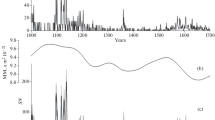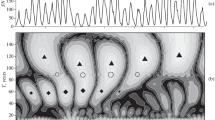Abstract
Of the solar-activity cycles with a period exceeding 22 years, the secular cycle, known as the Gleissberg cycle, attracts the most attention from researchers. In this paper, using the Fourier and wavelet analysis methods, we study the cyclicity of solar activity expressed by the sunspot number SN reconstructed from different sources (the length of the series is up to ~12 000 years) in the range of periods of the Gleissberg cycle. It was found that the Gleissberg cycle consists of three distinguished branches with average periods of 60, 88, and 140 years. The nature of the amplitude variation of all three branches is identical, which indicates that they are part of one quasi-periodic process. The analysis showed that the 88-year cycle is the main cycle. Its source is the solar dynamo. The 60- and 140-year cycles are the result of frequency modulation of the main cycle by a process with a period of 224 years (Suess cycle). A model that confirms and explains this result has been developed. The Suess cycle, which is a frequency modulator of the Gleissberg cycle, most likely has an extrasolar origin. Our results do not support the hypothesis of a chaotic Sun, which is indicative of a more regular, quasi-periodic behavior of the solar dynamo.







Similar content being viewed by others
REFERENCES
Attolini, M.R., Cecchini, S., Galli, M., and Nanni, T., On the persistence of the 22-year solar cycle, Sol. Phys., 1990, vol. 125, pp. 389–398.
Babcock, H.W., The topology of the Sun’s magnetic field and the 22-year cycle, Astrophys. J., 1961, vol. 133, pp. 527–587.
Chol-jun, K. and Jik-su, K. About 200-year cycle of solar activity in the mediaeval Korean records and reconstructions from cosmogenic radionuclides. https://arxiv.org/ pdf/1912.11226.pdf. 2019.
Clilverd, M.A., Clarke, E., Ulich, T., Rishbeth, H., and Martin, J., Predicting solar cycle 24 and beyond, Space Weather, 2006, vol. 4, no. 9, S09005. https://doi.org/10.1029/2005SW00027
Damon, P.E. and Jirikowic, J.L., The Sun as a low-frequency harmonic oscillator, Radiocarbon, 1992, vol. 34, pp. 199–205.
Daubechies, I., Ten Lectures on Wavelets, Philadelphia, Pa.: Society for Industrial and Applied Mathematics, 1992. https://doi.org/10.1137/1.9781611970104
Feynman, J. and Fougere, P.F., Eighty-eight year periodicity in solar–terrestrial phenomena confirmed, J. Geophys. Res., 1984, vol. 89, pp. 3023–3027.
Feynman, J. and Gabriel, S.B., Period and phase of the 88-year solar cycle and the Maunder minimum: Evidence for a chaotic Sun, Sol. Phys., 1990, vol. 127, pp. 393–403.
Feynman, J. and Ruzmaikin, A., The centennial Gleissberg cycle and its association with extended minima, J. Geophys. Res.: Space, 2014, vol. 119, pp. 6027–6041. https://doi.org/10.1002/2013JA019478
Gleissberg, W., Evidence for a long solar cycle, Observatory, 1944, vol. 65, no. 282, pp. 123–125.
Gleissberg, W., The eighty-year solar cycle in auroral frequency numbers, J. Br. Astron. Assoc., 1965, vol. 75, pp. 227–231.
Gonorovskii, I.S., Chastotnaya modulyatsiya i ee primeneniya (Frequency Modulation and Its Applications), Moscow: Svyaz’izdat, 1948.
Grossman, A. and Morlet, J., Decomposition of Hardy functions of constant shape, SIAM J. Math., 1984, vol. 15, no. 4, pp. 723–736. https://doi.org/10.1137/0515056.m
Hathaway, D.H., The solar cycle, Living Rev. Sol. Phys., 2015, vol. 12, p. 4. https://doi.org/10.1007/lrsp-2015-4
Kolláth, Z. and Oláh, K., Multiple and changing cycles of active stars I. Methods of analysis and application to the solar cycles, Astron. Astrophys. Manuscript, no. 11303. https://arxiv.org/pdf/0904.1725. https://doi.org/10.1051/0004-6361/200811303.
Komitov, B., Sello, S., Duchlev, P., Dechev, M., Penev, K., and Koleva, K., The sub- and quasi-centurial in solar and geomagnetic activity data series, Bulg. Astron. J., 2016, vol. 25, pp. 78–103.
Kuklin, G.V., Cyclical and secular variations of solar activity, in Basic Mechanisms of Solar Activity, Bumba, V. and Kleczek, J., Boston, Mass.: D. Reidel, 1976, pp. 147–190.
Lin, Y.C., Fan, C.Y., Damon, P.E., and Wallick, E.I., Long term modulation of cosmic ray intensity and solar activity cycles, in Proc. of the 14th Int. Cosmic Ray Conference, Garching, Germany, Max Planck Inst. für extraterrestrische Physik, 1975, vol. 3, pp. 995–999.
Ma, L.H., Gleissberg cycle of solar activity over the last 7000 years, New Astron., 2009, vol. 14, pp. 1–3. https://doi.org/10.1016/j.newast.2008.04.001
Ma, L.H. and Vaquero, J.M., Is the Suess cycle present in historical naked-eye observations of sunspots?, New Astron., 2009, vol. 14, pp. 307–310. https://doi.org/10.1016/j.newast.2008.09.003
McCracken, K.G., Beer, J., Steinhilber, F., and Abreu, J., A phenomenological study of the cosmic ray variations over the past 9400 years, and their implications regarding solar activity and the solar dynamo, Sol. Phys., 2013, vol. 286, no. 2, pp. 609–627.
Nachasova, I.E. and Akimova, S.V., The geomagnetic field intensity variations in the Iberian Peninsula during the last millennium, Izv., Phys. Solid Earth, 2015, vol. 51, no. 5, pp. 709–715. https://doi.org/10.7868/S0002333715050087
Nagovitsyn, Yu.A., Solar activity during the last two millennia: “Solar Patrol” in ancient and medieval China, Geomagn. Aeron. (Engl. Transl.), 2001, vol. 41, no. 5, pp. 680–688.
Ogurtsov, M.G., Nagovitsyn, Yu.A., Kocharov, G.E., and Jungner, H., Long-period cycles of the Sun’s activity recorded in direct solar data and proxies, Sol. Phys., 2002, vol. 211, nos. 1–2, pp. 371–394.https://doi.org/10.1023/A:1022411209257
Peristykh, A.N. and Damon, P.E., Persistence of the Gleissberg 88 year cycle over the last ~12,000 years: Evidence from cosmogenic isotope, J. Geophys. Res.: Space Phys., 2003, vol. 108, no. A1, pp. SSH 1-1–SSH 1-15. https://doi.org/10.1029/2002JA009390
Pipin, V.V., The Gleissberg cycle by a nonlinear a dynamo, Astron. Astrophys., 1999, vol. 346, pp. 295–302.
Pipin, V.V., Sokoloff, D.D., and Usoskin, I.G., Variations of the solar cycle profile in a solar dynamo with fluctuating dynamo governing parameters, Astron. Astrophys., 2012, pp. 1–11. https://doi.org/10.1051/0004-6361/201118733
Ptitsyna, N.G. and Demina, I.M., Reconstruction of the solar activity in 1000–1700 based on auroral data with allowance for the contribution of the main magnetic field of the Earth, Geomagn. Aeron. (Engl. Transl.), 2020, vol. 60, no. 3, pp. 495–506. https://doi.org/10.1134/S0016793220030159
Ptitsyna, N.G. and Demina, I.M., Solar-activity cycles reconstructed from statistics on polar lights with allowance for the contribution of the main magnetic field of the Earth in 1000–2000, Geomagn. Aeron. (Engl. Transl.), 2021, vol. 61, no. 2, pp. 312–324. https://doi.org/10.1134/S0016793221020122
Ribes, E., Merlin, P., Ribes, J.C., and Barthalo, R., Absolute periodicities of the solar diameter, derived from historical and modern time-series, Ann. Geofis., 1989, vol. 1, pp. 321–329.
Scargle, J.D., Wavelet and other multi-resolution methods for time series analysis, in Statistical Challenges in Modern Astronomy II, Babu G.J. and Feigelson, E.D., Eds., New York: Springer, 1997, pp. 333–347.
Schove, D.J., The sunspot cycle, 649-BC to AD-2000, J. Geophys. Res., 1955, vol. 60, pp. 127–146.
Silverman, S.M., Secular variation of the aurora for the past 500 years, Rev. Geophys., 1992, vol. 30, no. 4, pp. 333–351.
Siscoe, G.L., Evidence in the auroral record for secular solar variability, Rev. Geophys., 1980, vol. 1, no. 8, pp. 647–658.
Solanki, S.K., Usoskin, I.G., Kromer, B., Schüssler, M., and Beer, J. Unusual activity of the Sun during recent decades compared to the previous 11,000 years, Nature, 2004, vol. 431, pp. 1084–1087. https://doi.org/10.1038/nature02995
Sonett, C.P., Sunspot time series: Spectrum from square law modulation of the hale cycle, Geophys. Res. Lett., 1982, vol. 9, pp. 1313–1316.
Svalgaard, L., Up to nine millennia of multimessenger solar activity, 2018. https://arxiv.org/ftp/arxiv/papers/1810/ 1810.11952.pdf.
Tobias, S.M., Grand minima in nonlinear dynamos, Astron. Astrophys., 1996, vol. 307, pp. L21–L24.
Usoskin, I.G., A history of solar activity over millennia, Living Rev. Sol. Phys., 2017, vol. 14, no. 3, pp. 1–94. https://doi.org/10.1007/s41116-017-0006-9
Usoskin, I.G., Solanki, S.K., and Kovaltsov, G.A., Grand minima and maxima of solar activity: New observational constraints, Astron. Astrophys., 2007, vol. 471, pp. 301–309. https://doi.org/10.1051/0004-6361:20077704
Vecchio, A., Lepreti, F., Laurenza, M., Alberti, T., and Carbone, V., Connection between solar activity cycles and grand minima generation, Astron. Astrophys., 2017, vol. 599, pp. 292–304. https://doi.org/10.1051/0004-361/201629758
Weiss, N.O., Cattaneo, F., and Jones, C.A., Periodic and aperiodic dynamo waves, Geophys. Astrophys. Fluid Dyn., 1984, vol. 30, no. 4, pp. 305–341. https://doi.org/10.1080/03091928408219262
Wilson, S.G., Digital Modulation and Coding, Charlottesville, Va.: Prentice-Hall, 1996.
Author information
Authors and Affiliations
Corresponding authors
Ethics declarations
The authors declare that they have no conflicts of interest.
Additional information
Translated by E. Morozov
Rights and permissions
About this article
Cite this article
Ptitsyna, N.G., Demina, I.M. Frequency Modulation as a Cause of Additional Branches of the Gleissberg Cycle in Solar Activity. Geomagn. Aeron. 61 (Suppl 1), S48–S61 (2021). https://doi.org/10.1134/S0016793222010169
Received:
Revised:
Accepted:
Published:
Issue Date:
DOI: https://doi.org/10.1134/S0016793222010169




